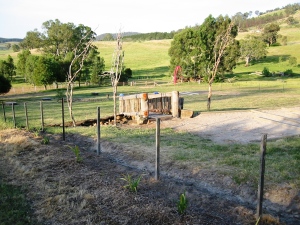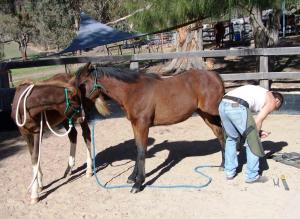By Judy Oldmeadow , Owner & Master Horsewoman, Samaria Creek Morgan Horses
What Horses Eat
Horses have a long gut and are relaxed and content when it’s uniformly full. Nature designed them to eat large amounts of various pasture and herbage.
Given the choice, they browse on sticks, leaves, berries and seeds – as well as grass and weeds.
Wild horses roam large areas to obtain food. At the mercy of climate and predators (including man) they often die of starvation or thirst.
Making Hay
Our farm is ideally suited to horses’ feed, exercise and herd companionship needs. Cutting our own hay lets us add necessary dry feed when it’s not available in their paddocks.
I believe round bales are best suited for supplementary feeding. This lets horses choose when to eat to keep their gut comfortable and still graze for variety.
When horses are fed extra hay as segments of small square bales, they wait hours at the fence for their human to deliver it – thus missing the exercise and extra nutrients of grazing.
Ad lib round bale feeding reduces competitive fighting (and resulting injuries) when hay is delivered to a herd once or twice a day.
We aim to improve on nature with the environment we provide for our horses. Cutting round bales for paddock supplement and small square bales for convenience enables this.
When we sell a horse, their new owners can take some small square bales home to help prevent the gut upsets often caused by a new feed regime.
Learning
Miles and I attended a six-week Sustainable Whole Farm Planning course in July 2007 at the Department of Sustainability & Environment.
Topics included land classification, soils, water, fire safety, pastures and a SWOT (strengths, weaknesses, opportunities and threats) analysis.
Our project focused on hay. We chose a seven hectare paddock and aimed to bale enough hay for two years’ use and to sell the rest to cover the cost of cutting.
Strengths
- Sheltered paddock with easy access for weed and pest control.
- Variety of pasture suitable for horses.
- Suitable soil type.
Weaknesses
- Weeds.
- Native animal pests.
Opportunities
- Low cost, weed-free hay that’s ideal for our horses.
- Free, natural reseeding from cutting every second year.
- Superior young horses with sound feet, joints and bones.
- Fewer injuries and illness.
- Improved paddock condition via rotational grazing and understocking paddocks.
Threats
- Fire.
- Low rainfall.
Dreams into Action
We concentrated our weed and pest control efforts on this paddock and capitalised our strengths via rotational grazing (heavy in winter, conservative in summer).
In November 2007, we cut enough round bales for two years. Our excess top-quality hay fetched a premium price and we had the added advantage of a fire-safe paddock over summer.
After two years, we only had two round bales left and had to buy 150 square bales for horses in yards or on outings.
Our paddock improved after a year of good rain and controlled grazing. In October 2009, we cut 100 large round and 240 small square bales! 🙂
Our SWOT analysis helped us achieve our goals. We look forward to continuing to give our horses optimum conditions.
🙂







